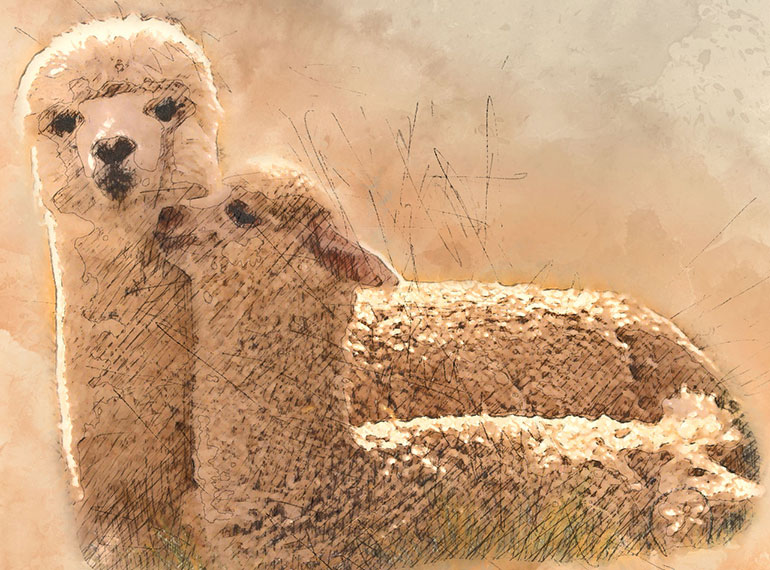
If you’re traveling to villages within this mountain range at about 3,500 meters above sea level, then you will see alpacas up close for the first time.
What is alpaca wool?
Alpaca wool is collected from an alpaca animal, a small, slender member of the camel family.
This is a camel species that is indigenous to South America.
People often mistaken the alpaca for a llama because they have similar physical characteristics. If you were to ask the average person outside of South America what an alpaca was, they probably wouldn’t be able to tell you.
The biggest herds of alpacas can be found in high-altitude locations in the Andes Mountains of Ecuador, Bolivia, Chile, and Peru.
If you’re traveling to villages within this mountain range at about 3,500 meters above sea level, then you will see alpacas up close for the first time.
There are a few big differences between alpaca and llamas.
For starters, llamas are raised as pack animals that carry weight on their backs.
This is to help people transport items across the terrain where there are no automobiles.
Llamas are also raised for meat consumption too.
Their meat will usually be eaten after their fleece is extracted for use as clothing material. As for alpacas, they are raised for a different purpose. The natural fabric of their outer skin is what people love about them.
This woolly fur covering of their body is known as “alpaca fleece.”
Why you should use alpaca?
In many parts of the world, alpaca wool is viewed as a luxurious fabric.
The reason for this is that alpaca wool is very rare, since these animals are raised in a limited number of remote locations in the Andes Mountains. Outside of these locations, the alpacas are typically no where to be found. Because of this, the value of their wool fabric is very high on the open market.
People pay lots of money to own clothing and materials that are made from alpaca wool. The rarity of the material makes people feel special if they own it. That is why the most common people to wear alpaca wool are those who are wealthy or are of royalty.
However, you don’t have to be wealthy or from a royal family to enjoy alpaca wool.
You could purchase a shirt, coat, nightgown, or bathrobe made from alpaca fleece for between $100 and $300.
While this may be more money than what you would normally spend on such items, it is not a significant amount that is going to break the bank.
If you are interested in purchasing and owning clothing made from such rare material like this, then it will be a worthy investment.
Here are 9 important properties of this kind of wool

1
It is soft and considered to be luxury wool, as Cashmere wool
However, you will notice that alpaca wool is much softer than cashmere wool.
This is mainly due to the special farms that are structured specifically to produce super soft alpaca wool.
They do this through carefully organized breeding programs where the objective is to produce fleece that is between 16 and 18 microns.
Any expert of this industry knows that alpaca fleece within this range of microns is considered to be luxurious and “royal.” Not only that, there are no scales on alpaca fleece like there are on other types of wool.
As a result, alpaca fleece is raised to feel a lot smoother and without being susceptible to staining.
2
Because is lanolin free, it is the perfect wool for people with sensitive skin, including babies.
Lanolin is a fatty substance which is produced by sheep.
People who wear the wool of sheep on their skin could experience irritation there if they have sensitive skin. This irritation could cause symptoms
like redness, rash, itchiness, or other forms of inflammation.
However, with alpaca wool, the wearer will not experience any of these symptoms because there are no lanolin properties in the material.
This means that people with sensitive skin do not have to worry about experiencing any irritation or inflammatory symptoms.
3
It is hypoallergenic.
Alpaca wool is deemed hypoallergenic.
This means that there are no substances or properties of alpaca wool which are likely to cause an allergic reaction to anyone who is exposed to the material.
Not only is this good news for people who have sensitive skin, but it is good news for anyone who is sensitive to allergens and fatty substances.
4
Alpaca wool fiber is unique and light-weight.
The fibers of alpaca wool make it quite a unique material.
Since these fibers contain numerous microscopic air bubbles in them, the wool material ends up weighing as little as a sponge.
Compare this to the traditional forms of wool which often feel hard and heavy.
Alpaca wool is superior because it is soft, lightweight, clean, and still durable all at the same time.
When you wear clothing made from alpaca wool, you will barely feel anything on your body.
This makes it great for running, walking, or even skiing.
5
It is eco-friendly
Did we mention that alpaca wool is eco-friendly?
You might wonder how this can be when the wool is retrieved from the alpaca animal.
Well, it all has to do with the feeding potential of the alpacas.
You see, alpacas do not eat as much food as sheep. When the alpacas do eat, they are usually eating the grass from the ground.
Since these animals are raised in elevations about 10,000 feet from sea level, there are not too many other animals sharing the grass food with them. This leaves the grass all to the
alpacas to enjoy when they’re hungry.
In addition, the hooves on an alpaca are very wide and will often loosen the soil below them as they step down on it.
Whenever you have loosened soil, you will have grass and other vegetation growing much faster.
This means that merely walking on the ground is allowing the alpacas to grow more food for themselves.
How neat is that?
6
It is 100% biodegradable.
The fur and hairs on the alpaca wool are 100% biodegradable.
They consist of special proteins which allow the hairs to break down after a short time period.
Once they are done breaking down, they will be recycled back into the earth as if they were never there.
This is just one more reason that alpaca wool is environmentally friendly.
You will never be polluting the environment by purchasing and wearing this natural fabric.
7
Alpaca is considered to be a higher quality fiber.
We’ve already established that alpaca wool is considered to be a higher quality fibrous material because of its rarity and value.
But the material itself is also very strong and durable, despite how silky and smooth it feels.
After all, how else could the alpaca animals survive in the cold temperatures of such high altitudes if they didn’t have a strong protective coating to keep themselves warm?
You can be sure that you’ll be kept warm if you wear alpaca wool clothing too.
8
Alpaca fiber does not retain moisture.
So, if you are wearing clothing made from this material and you are caught in a rainstorm, do not worry about the fabric getting ruined.
You can wear alpaca wool in virtually all wet and rainy conditions while staying very dry.
Plus, this material is resistant to odors too.
9
We just mentioned that alpaca wool will keep you warm when it is cold outside.
However, it can also keep you cool when you are about to become overheated.
Don’t forget that alpaca wool has all those microscopic air bubbles in them to let air pass through.
This mean that some outside air will be able to get through to your skin, so that it can stay refreshed and oxygenated.
How well do you know alpacas?
These animals might be used for their fleece, but that doesn’t mean they can’t be admired for their loving nature while they’re alive.
It really doesn’t take much to raise these animals either because they live off the grass and the land.
The best part is they can survive in both cold temperatures and hot temperatures, so it is very rare for the weather to affect their living conditions.
Was alpaca wool called the fiber of the gods by the ancient Incan Empire?
During the time period of the Incan civilization, alpaca was only used for royalty.
Ordinary people did not wear alpaca-based clothing because it was reserved for the Incan leaders only.
Is Alpaca a friendly and gentle animal?
Alpacas are no threat to human beings.
This is the reason that people in some countries use alpacas for therapeutic purposes.
They simply make contact with them and instantly feel better.
It is kind of like how westerners feel better when they spend time with dogs and cats.
Is Alpaca an clean and hygienic animal?
Wool is used for sweaters, hats, beds, stockings, coats, scarves, gloves, blankets, and the very popular poncho.
Since the alpaca wool material does not stain or retain moisture, this makes the animals themselves very clean on the outside.
Also, their diet consists of mostly grass vegetation, so they are not messy eaters either.
Alpacas are curious animals!
They love to be caressed by their master if he gained their trust!
Try petting them like you would pet your dog or cat and they will certainly appreciate it.
You can read more about alpaca on:https://en.wikipedia.org/wiki/Alpaca_fiberhttps://www.quora.com/What-makes-alpaca-fur-so-expensive


